Excerpts from Jim Conrad's
Naturalist Newsletter
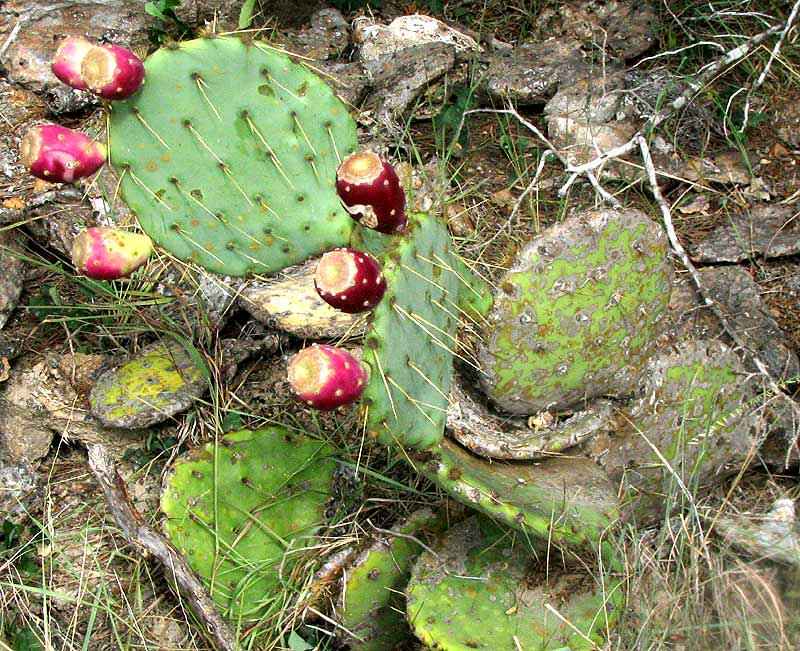
from the the September 9, 2012 Newsletter issued from the valley of the Dry Frio River in northern Uvalde County, southwestern Texas, on the southern border of the Edwards Plateau; elevation ~1750m (~5750 ft); N29.62°, W99.86°; USA
TEXAS PRICKLYPEAR
On a rocky ledge over the Dry Frio River right behind the cabin several pricklypear cacti are now adorned with egg-shaped, egg-sized fruits, or tunas, as shown above.
In general, cactus taxonomy is a mess, maybe because few taxonomists want to work with such spiny, hard-to collect plants as cacti. In the Cactus Family, the Cactaceae, one of the biggest and most easy-to-recognize kinds of cactus is the pricklypear group, genus Opuntia. The cactus in our picture is a pricklypear, a fairly representative one with its beavertail-shaped pads (modified stem segments) arising from one another. But which of the 34 or so North American pricklypear species is it?
Important field marks to notice for this species include that the plant is sprawling instead of rising on a sturdy trunk, and that the pads are fairly large and broad, sometimes almost circular. The pads are dull green, not a lustrous, deep green. The groups of spines are relatively widely spaced across the pads' faces, and the spines themselves are pale yellowish, not grayish, and tend to point downwards. Other important field marks are shown in a close-up of one of the little bumps, or areoles, from which spines arise, below:
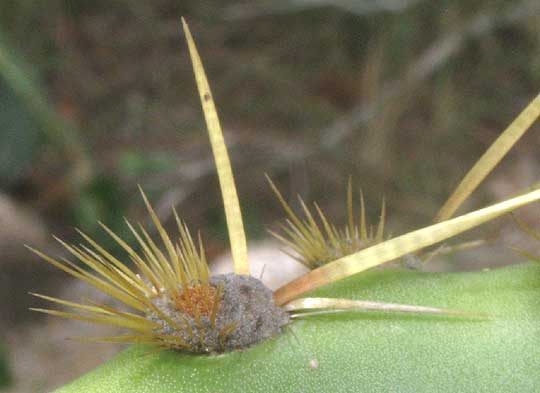
There you see that the large spines are flattish at their bases, and only slightly reddish instead of dark red. The numerous small spines at the base, called glochids, cluster on one side of the areole and, for glochids, are unusually large. These are important matters in pricklypear identification!
Keying our cactus out in the online Flora of North America leads to the name OPUNTIA ENGELMANNII var. LINDHEIMERI, often known as the Texas Pricklypear. This variety, lindheimeri, is typical of the Chihuahuan Desert of northern Mexico and southern Texas. The broader species is found from southern California north to Utah, east through southern Texas, and south through much of arid northern Mexico. Also, the broader Opuntia engelmannii is one of the most taxonomically difficult and tossed-about of all pricklypear species. Each of my three cactus field guides uses a different binomial name for it.
Del Weniger, author of Cacti of Texas and Neighboring States -- a book that delighted me while backpacking in Big Bend National Park a few years ago -- is a real cactus lover, yet on his page for the Texas Pricklypear uncharitably he refers to this lindheimerii variety of Opuntia engelmannii as the "worst pest pear of south Texas." I personally have always been pleased to meet it, however, and find nothing pestiferous about it. I think he is trying to say that the species is uncommonly flexible in its habitat requirements, and is capable of surviving in many places humans disturb.
from the April 28, 2013 Newsletter issued from the Frio Canyon Nature Education Center in northern Uvalde County, southwestern Texas, on the southern border of the Edwards Plateau; elevation ~1750m (~5750 ft); N29.62°, W99.86°; USA
FLOWERING PRICKLYPEARS
I've been waiting for the pricklypears to begin flowering, and now they have, as you can see below:

Below you see a close-up of how the rose-like, rose-tinted flowers cluster atop the pads:
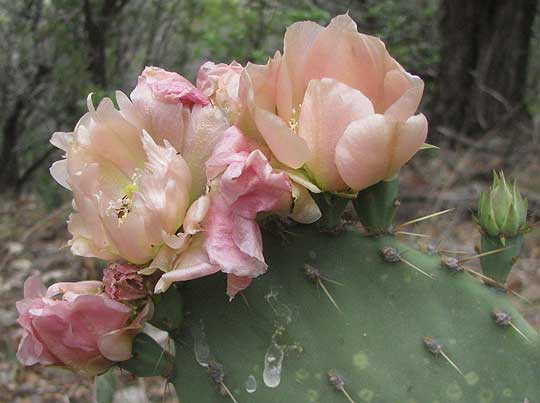
A view inside a blossom showing it colonized by beetles, and from its center arising a thick, pink style with a large, yellow, oval stigma atop it is shown below:
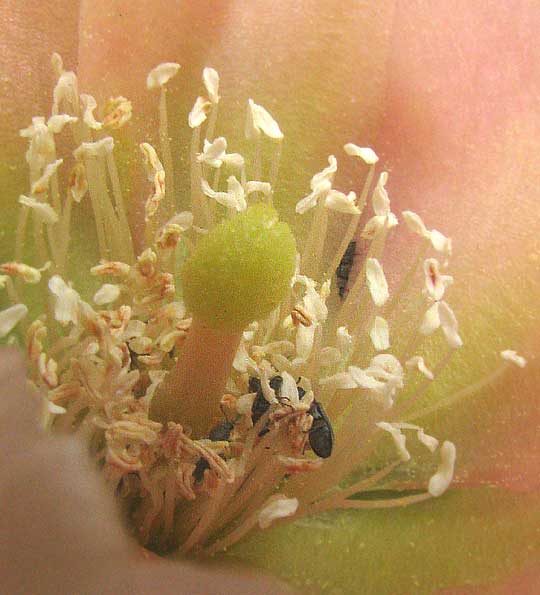
Noting these colors was useful because they vary from species to species. Spine color, number and configuration of the confined area they arise from -- their "areoles" -- also is important, so they are shown below:
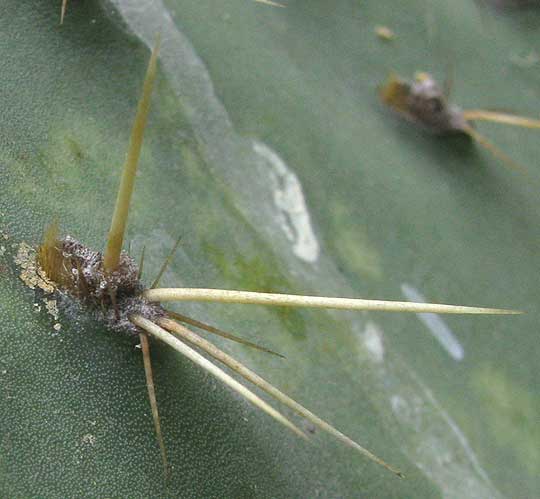
Already we've identified the abundant cactus on the valley floor and surrounding hills' lower slopes as the Texas Pricklypear, Opuntia engelmannii var. lindheimeri. Since the ones on the valley floor haven't begun flowering yet and the individual pictured above was near the crest of a limestone hill, I had hopes that this would a new species for us.
However, using the key to pricklypears available online in the Flora of North America, of the 34 pricklypear species known to occur in the US, the key led me directly to our plentiful Texas Pricklypear. You can try your own hand at IDing the flowering cactus shown in our photos at http://www.efloras.org/florataxon.aspx?flora_id=1&taxon_id=123045.
I still have hopes of finding other pricklypear species here, but I won't be able to identify them until they flower.
from the June 16, 2013 Newsletter issued from the Frio Canyon Nature Education Center in northern Uvalde County, southwestern Texas, on the southern border of the Edwards Plateau; elevation ~1750m (~5750 ft); N29.62°, W99.86°; USA
PRICKLYPEAR SEEDLINGS
In very thin, dry soil exactly at the lip of a limestone cliff dropping to the little Dry Frio River behind the cabin a couple of cylindrical, four-inch tall (10cm) cactuses showed up, one of which is shown below:

A close-up of the cactus's clusters of spines appears below:

In our area we have cylindrical cactus species bearing clusters of numerous slender spines radiating from a point, as shown above, but I've not seen them in the wild, despite our being in their area of natural distribution. You see them in people's yards, and I'm guessing that basically that species has gone extinct in this area because of people digging them up.
However, even mature pricklypear cactuses with flat, beavertail-shaped stem segments, or pads, start out as cylindrical seedlings, and that's what I think is shown in the picture. Since several large, prolifically fruiting Texas Pricklypears, Opuntia engelmannii var. lindheimeri, were growing just a few feet away, so I'm supposing that that's what is shown in the picture.
In the last picture notice toward the cactus body's top, in each spine cluster a single spine is pinkish and more robust than the surrounding paler and much smaller spines. Mature spine clusters of the Texas Pricklypear normally develop only one or two large spines per cluster.
entry from March 20, 2022, issued from near Tequisquiapan, elevation about 1,900m (6200 ft), Querétaro state, MÉXICO
VARIETY CUIJA FLOWERING
The local tree-cactus usually identified by Mexican botanists as Opuntia engelmannii variety cuija is flowering now, as shown below:

I've been eager to see these blossoms, particularly because the tree form of this cactus is so unlike what I've seen on other Opuntia engelmannii varieties. Above we show some pinkish blossoms, which is in agreement with the Flora of North America, which says that among the species' various varieties flower color can range from uniformly yellow to buff, sometimes orange to pink to red, and rarely whitish. You may like to see the GBIF distribution map for the cuija variety
In the above picture, the blossom at the left clearly shows the slender stigma lobes emerging from the clumps of small, white stamens. The flower at the right shows the stamens better. A closer shot of the stigma lobes and stamens appears below.

When compared with the above picture of Opuntia engelmannii variety lindheimeri in southwestern Texas, our cuija stamens look smaller, more numerous and the anthers more twisted. But possibly these impressions are to be explained by our cuija picture showing a blossom with the stigmas more developed, plus it's much drier here that where the lindheimeri picture was taken. Whatever the case, it's up to a future expert to decide whether our cuija constitutes a different species, or should remain as a mere variety of the very widespread and varied Opuntia engelmannii.
entry from May 8, 2022, issued from near Tequisquiapan, elevation about 1,900m (6200 ft), Querétaro state, MÉXICO
VARIETY CUIJA GENERAL FORM
In this area we have three commonly occurring, tree-type cactus species, of which our variety chija is compared to one, shown below. :
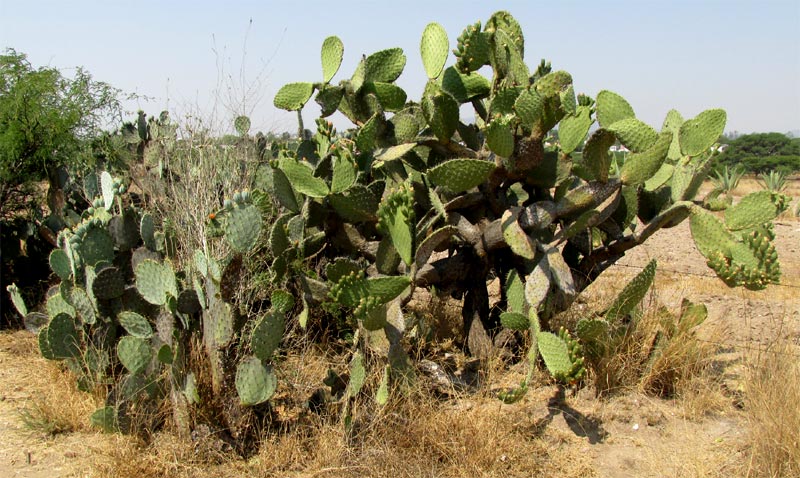
I think these are the same age, in human terms "young adult" plants, neither as tall or with trunks developed as well as they can be. On the left is Opuntia engelmannii var. cuija; on the right is Opuntia streptacantha. The other similar tree-cactus species is Opuntia tomentosa.
Note the relatively somewhat pale, "glaucous" appearance of Opuntia engelmannii var. cuija, and its rounder pads. The same difference is seen with both of the other species. Here's another way variety cuija can look:
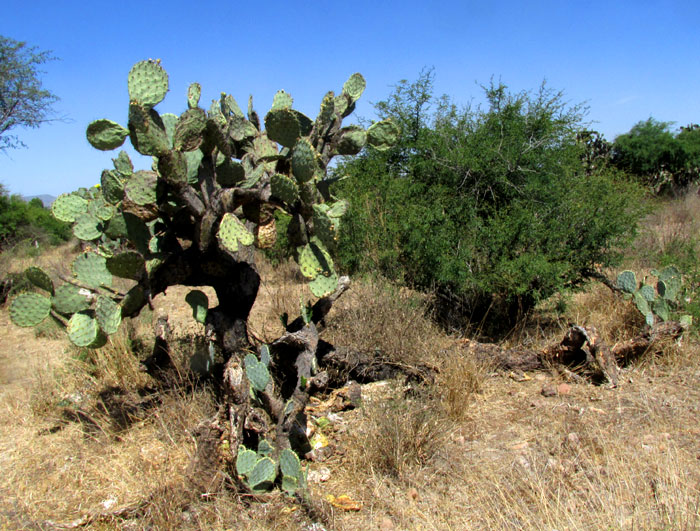
Note that the tall cactus at the left is connected by a thick, black trunk lying on the ground with a small cactus at the far right. That's all the same cactus. The trunk was erect at one time, fell over, and the main body curved upward to form the bent trunk the larger body issues from. The smaller cactus at the right sprouted from the base of the original upright trunk. This is very typical of variety cuija, at least in this area. When given a chance, the plant's trunk grows upward while branching, until the whole thing falls over, often individual pads and sections of branch breaking away completely, developing their own roots, and eventually often forming new plants.
The soil here is thin so maybe in areas where the cactus can root among rocks this doesn't happen. The other two common tree-cactus species here, both averaging taller and with more slender pads -- Opuntia streptacantha and Opuntia velutina -- fall over much less. Maybe to variety cuija it's a matter of having rounder pads that gather more sunlight, but also provide more wind resistance so that they are blown over more, being compensated for by adapting to more vigorous vegetative reproduction by fragmentation.
Here's something else variety cuija does:
